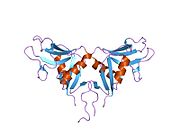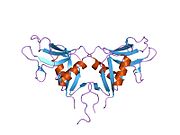OLR1
گیرندهٔ ۱ لیپوپروتئین کمچگالی اکسیدهشده (انگلیسی: Oxidized low-density lipoprotein receptor 1) که با نام گیرندهٔ لیپوپروتئین کمچگالی اکسیدهشده شبه لکتین (LOX-1) هم شناخته میشود، یک پروتئین است که در انسان توسط ژن «OLR1» کُدگذاری میشود.[۴][۵]
این پروتئین، گیرندهٔ اصلی لیپوپروتئین کمچگالی اکسیدهشده در لایههای درونرگی، ماکروفاژها، ماهیچههای صاف[۶] و سایر انواع یاختههاست.[۷] قابل ذکر است که که اگر لیپوپروتئین کمچگالی به میزان بسیار اندکی اُکسیده شده باشند، با گیرندهٔ TLR4 و اگر به میزان بسیار زیادی اُکیسده شده باشند، با گیرندهٔ CD36 بهتر شناسایی میشوند.[۸]
این پروتئین احتمالاً در تنظیم فرایند آپوپتوزی که توسط لیگاند فاس آغاز میشود، نقش دارد.
جهش در ژن «OLR1» با بروز تصلب شرایین و سکته قلبی و بیماری آلزایمر مرتبط است.[۵] در محیطهای آزمایشگاهی (و نه در بدن حیوانات و انسان) افزودن مکمل غذایی طبیعی بربرین به سلولهای فوم حاصله از ماکروفاژها، بیان ژن «OLR1» را در پاسخ به «لیپوپروتئین کمچگالی اکسیدهشده»، مهار میکند.[۹]
منابع[ویرایش]
- ↑ ۱٫۰ ۱٫۱ ۱٫۲ GRCm38: Ensembl release 89: ENSMUSG00000030162 - Ensembl, May 2017
- ↑ "Human PubMed Reference:". National Center for Biotechnology Information, U.S. National Library of Medicine.
- ↑ "Mouse PubMed Reference:". National Center for Biotechnology Information, U.S. National Library of Medicine.
- ↑ Li X, Bouzyk MM, Wang X (Nov 1998). "Assignment of the human oxidized low-density lipoprotein receptor gene (OLR1) to chromosome 12p13.1→p12.3, and identification of a polymorphic CA-repeat marker in the OLR1 gene". Cytogenet Cell Genet. 82 (1–2): 34–6. doi:10.1159/000015059. PMID 9763655.
- ↑ ۵٫۰ ۵٫۱ "Entrez Gene: OLR1 oxidized low density lipoprotein (lectin-like) receptor 1".
- ↑ Pirillo A, Norata GD, Catapano AL (2013). "LOX-1, OxLDL, and atherosclerosis". Mediators of Inflammation. 2013: 1–12. doi:10.1155/2013/152786. PMC 3723318. PMID 23935243.
- ↑ Xu S, Ogura S, Chen J, Little PJ, Moss J, Liu P (2013). "LOX-1 in atherosclerosis: biological functions and pharmacological modifiers". Cellular and Molecular Life Sciences. 70 (16): 2859–2872. doi:10.1007/s00018-012-1194-z. PMC 4142049. PMID 23124189.
- ↑ Zmysłowski A, Szterk A (2017). "Current knowledge on the mechanism of atherosclerosis and pro-atherosclerotic properties of oxysterols". Lipids in Health and Disease. 16 (1): 188. doi:10.1186/s12944-017-0579-2. PMC 5625595. PMID 28969682.
- ↑ Guan S, Wang B, Li W, Guan J, Fang X (2010). "Effects of berberine on expression of LOX-1 and SR-BI in human macrophage-derived foam cells induced by ox-LDL". Am J Chin Med. 38 (6): 1161–9. doi:10.1142/s0192415x10008548. PMID 21061468.
- مشارکتکنندگان ویکیپدیا. «OLR1». در دانشنامهٔ ویکیپدیای انگلیسی، بازبینیشده در ۲۶ دسامبر ۲۰۱۹.
برای مطالعهٔ بیشتر[ویرایش]
- Sawamura T (2002). "[Molecular identification of LOX-1 and analysis of its pathophysiological role]". Nippon Yakurigaku Zasshi. 119 (3): 145–54. doi:10.1254/fpj.119.145. PMID 11915516.
- Mehta JL, Li D (2002). "Identification, regulation and function of a novel lectin-like oxidized low-density lipoprotein receptor". J. Am. Coll. Cardiol. 39 (9): 1429–35. doi:10.1016/S0735-1097(02)01803-X. PMID 11985903.
- Sawamura T (2002). "[LOX-1: the oxidized LDL receptor expressed in vascular endothelial cells]". Seikagaku. 74 (5): 365–76. PMID 12073608.
- Ando K, Fujita T (2005). "Role of lectin-like oxidized low-density lipoprotein receptor-1 (LOX-1) in the development of hypertensive organ damage". Clin. Exp. Nephrol. 8 (3): 178–82. doi:10.1007/s10157-004-0288-9. PMID 15480893.
- Sawamura T, Kume N, Aoyama T, et al. (1997). "An endothelial receptor for oxidized low-density lipoprotein". Nature. 386 (6620): 73–7. Bibcode:1997Natur.386...73S. doi:10.1038/386073a0. PMID 9052782.
- Yoshida H, Kondratenko N, Green S, et al. (1998). "Identification of the lectin-like receptor for oxidized low-density lipoprotein in human macrophages and its potential role as a scavenger receptor". Biochem. J. 334 (Pt 1) (Pt 1): 9–13. doi:10.1042/bj3340009. PMC 1219654. PMID 9693095.
- Mehta JL, Li DY (1998). "Identification and autoregulation of receptor for OX-LDL in cultured human coronary artery endothelial cells". Biochem. Biophys. Res. Commun. 248 (3): 511–4. doi:10.1006/bbrc.1998.9004. PMID 9703956.
- Yamanaka S, Zhang XY, Miura K, et al. (1999). "The human gene encoding the lectin-type oxidized LDL receptor (OLR1) is a novel member of the natural killer gene complex with a unique expression profile". Genomics. 54 (2): 191–9. doi:10.1006/geno.1998.5561. PMID 9828121.
- Nagase M, Abe J, Takahashi K, et al. (1999). "Genomic organization and regulation of expression of the lectin-like oxidized low-density lipoprotein receptor (LOX-1) gene". J. Biol. Chem. 273 (50): 33702–7. doi:10.1074/jbc.273.50.33702. PMID 9837956.
- Draude G, Hrboticky N, Lorenz RL (1999). "The expression of the lectin-like oxidized low-density lipoprotein receptor (LOX-1) on human vascular smooth muscle cells and monocytes and its down-regulation by lovastatin". Biochem. Pharmacol. 57 (4): 383–6. doi:10.1016/S0006-2952(98)00313-X. PMID 9933026.
- Aoyama T, Sawamura T, Furutani Y, et al. (1999). "Structure and chromosomal assignment of the human lectin-like oxidized low-density-lipoprotein receptor-1 (LOX-1) gene". Biochem. J. 339 (Pt 1) (Pt 1): 177–84. doi:10.1042/0264-6021:3390177. PMC 1220142. PMID 10085242.
- Li DY, Zhang YC, Philips MI, et al. (1999). "Upregulation of endothelial receptor for oxidized low-density lipoprotein (LOX-1) in cultured human coronary artery endothelial cells by angiotensin II type 1 receptor activation". Circ. Res. 84 (9): 1043–9. doi:10.1161/01.res.84.9.1043. PMID 10325241.
- Kataoka H, Kume N, Miyamoto S, et al. (1999). "Expression of lectinlike oxidized low-density lipoprotein receptor-1 in human atherosclerotic lesions". Circulation. 99 (24): 3110–7. doi:10.1161/01.cir.99.24.3110. PMID 10377073.
- Li D, Saldeen T, Romeo F, Mehta JL (2000). "Oxidized LDL upregulates angiotensin II type 1 receptor expression in cultured human coronary artery endothelial cells: the potential role of transcription factor NF-kappaB". Circulation. 102 (16): 1970–6. doi:10.1161/01.cir.102.16.1970. PMID 11034947.
- Bull C, Sobanov Y, Röhrdanz B, et al. (2001). "The centromeric part of the human NK gene complex: linkage of LOX-1 and LY49L with the CD94/NKG2 region". Genes Immun. 1 (4): 280–7. doi:10.1038/sj.gene.6363678. PMID 11196705.
- Shi X, Niimi S, Ohtani T, Machida S (2001). "Characterization of residues and sequences of the carbohydrate recognition domain required for cell surface localization and ligand binding of human lectin-like oxidized LDL receptor". J. Cell Sci. 114 (Pt 7): 1273–82. PMID 11256994.
- Chen M, Narumiya S, Masaki T, Sawamura T (2001). "Conserved C-terminal residues within the lectin-like domain of LOX-1 are essential for oxidized low-density-lipoprotein binding". Biochem. J. 355 (Pt 2): 289–96. doi:10.1042/0264-6021:3550289. PMC 1221738. PMID 11284714.
- Tanimoto A, Murata Y, Nomaguchi M, et al. (2001). "Histamine increases the expression of LOX-1 via H2 receptor in human monocytic THP-1 cells". FEBS Lett. 508 (3): 345–9. doi:10.1016/S0014-5793(01)03073-3. PMID 11728449.
- Sobanov Y, Bernreiter A, Derdak S, et al. (2002). "A novel cluster of lectin-like receptor genes expressed in monocytic, dendritic and endothelial cells maps close to the NK receptor genes in the human NK gene complex". Eur. J. Immunol. 31 (12): 3493–503. doi:10.1002/1521-4141(200112)31:12<3493::AID-IMMU3493>3.0.CO;2-9. PMID 11745369.









